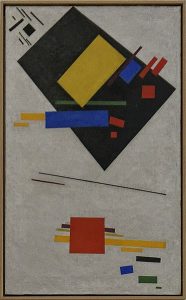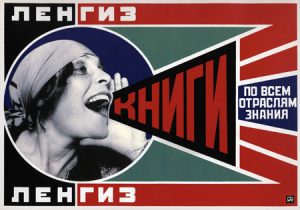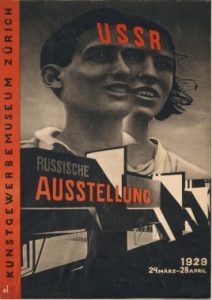Suprematism and Constructivism are two opposing art movements both of which originated in Russia in the early 20th Century. Russian artists, after the Russian Revolution, absorbed Cubism and Futurism to coin a term called Cubo-Futurism.

Image source: https://www.wikiart.org/en/
Kazimir Malevich, was the pioneer of geometric abstract art using abstraction, and non-objective geometric motifs in a style that later became an art movement called Suprematism. This artistic current is not about a feeling, but a sensation, while Constructivism born of a series of artists who rejected the idea of “art for art’s sake” began to devote themselves to the practical arts of industrial design and other visual communications.
Suprematism
The Suprematism of the Russian artist Kazimir Malevich has taken the essential aspects of Cubist painting to extremes. Malevich considered art free from the representation of recognizable figures and objects, in this way, art could develop its language of forms and create new realities ‘no less significant than the realities of nature itself’.

The key elements of supremacist art for Malevich were the straight line and the square, which reflected his emphasis on man rather than forms found in nature. ‘Under Suprematism’, said Malevich, ‘I understand the supremacy of pure sentiment in creative art.’ According to Malevich, a pure black square was the true ‘zero of the form’, the white space that extended the void behind it.
Constructivism

Image source: https://www.flickr.com/photos/bibi/2450669711 Author:Bianca Bueno
While Malevich felt strongly that art must have no connection with society, other painters in Russia of the same period, known as the ‘Constructivists’, had a more pragmatic and rigorous approach to non-representational painting. Around 1911, Mikhail Larionov had developed a style he called ‘Rayonnism’, a means of breaking up objects through rays of light, colors, and textures. Alexander Rodchenko worked on paintings based on abstract principles, which he later call ‘non-objective’, such as a series of works created in 1914 with the help of a ruler and compass. Liubov Popova (1889–1924) produced linear architectural compositions. All of these painters were involved in the applied arts, creating theatre sets, bindings, fabrics, and posters, so that their artistic experiments had a public, practical application.
Which are the differences?


Image source: https://en.wikipedia.org/wiki/Constructivism_(art)#/media/File:’Proun_Vrashchenia’_by_El_Lissitzky,_ca._1919.jpg
Image source: https://en.wikipedia.org/wiki/Suprematism#/media/File:Supremus_55_(Malevich,_1916).jpg
- Malevich’s Suprematism opposes the postrevolutionary positions of Constructivism and materialism. Constructivism, with its cult of the object, deals with utilitarian strategies for adapting art to the principles of functional organization. Under Constructivism, the traditional easel painter transforms into the artist-as-engineer in charge of organizing life in all its aspects. Suprematism, in stark contrast to Constructivism, embodies a profoundly anti-materialist, anti-utilitarian philosophy.
- Suprematism does not place man at the center of the universe, rather, it images man—the artist—as the creator and transmitter of what for Malevich is the only true reality in the world, that of absolute non-objectivity.
- Jean-Claude Marcadé observed that “Despite superficial similarities between Constructivism and Suprematism, the two movements are nevertheless antagonists and it is very important to distinguish them.” According to Marcadé, the confusion arose because several artists, such as El Lissitzky, later abandoned Suprematism for the culture of materials.
Constructivist Graphic Design
The book designs of Rodchenko, El Lissitzky, and others were a great inspiration for radical designers in the West, especially Jan Tschichold. Many Constructivists have worked on designing posters for everything from cinema to political propaganda.

Image source:https://www.flickr.com/photos/27862259@N02/7023225561 Author: kitchener.lord
In the late 1920s, Figurative Constructivism emerged from the group of Cologne Progressives, which had ties to Russian Constructivists, most notably Lissitzky, since the early 1920s. The collaboration of this group with Otto Neurath and the Gesellschafts- und Wirtschaftsmuseum meant that artists such as Gerd Antz, Augustin Tschinkel, and Peter Alma could influence the development of the Vienna Method.
Info sources: https://www.zythepsary.com/art20scourse/construct.html https://en.wikipedia.org/wiki/Suprematism https://en.wikipedia.org/wiki/Constructivism_(art) https://www.theartstory.org/movement/constructivism/ http://blog.flametreepublishing.com/art-of-fine-gifts/art-movements-suprematism-constructivism-purism-progressing-from-cubism
